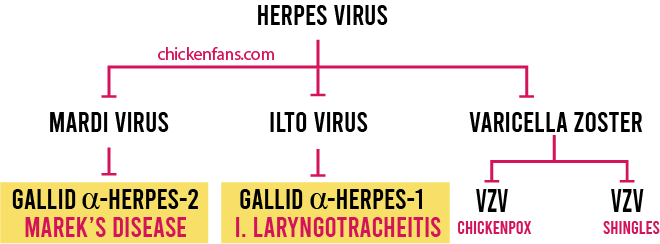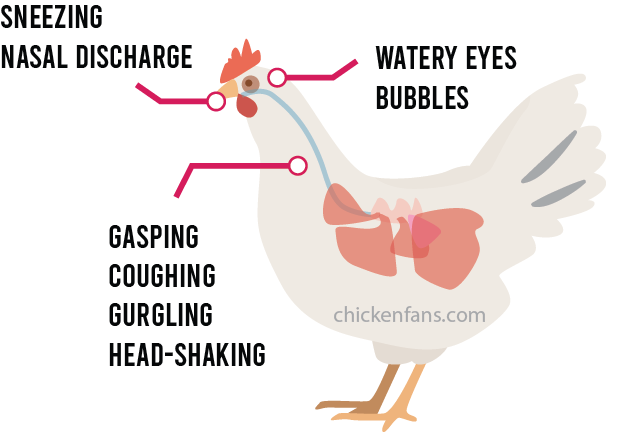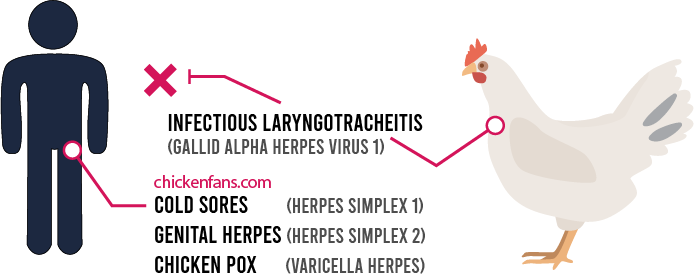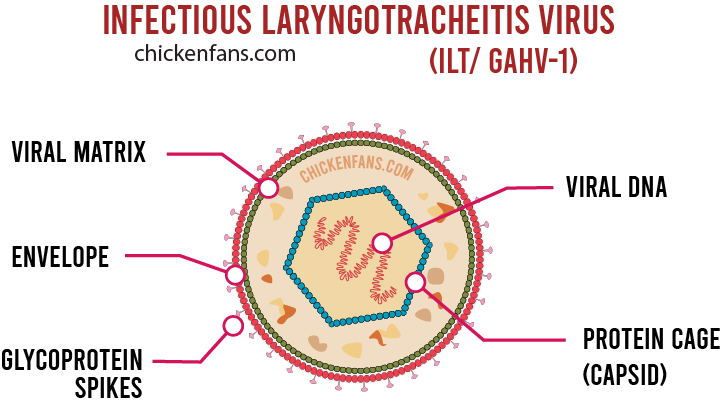Infectious Laryngotracheitis in Chickens


If your chicken is coughing, sneezing red mucus, shaking its head, and gasping for air, chances are it’s a case of infectious laryngotracheitis. This disease resembles other respiratory infections but can be fatal. The responsible virus resides in the same family as the terrible Marek’s disease virus.
Should you be worried?
Well, maybe a little bit. Let’s discuss.
- What is infectious laryngotracheitis?
- Symptoms of infectious Laryngotracheitis
- Transmission
- Vaccination
- Treatment
- Gallid Alphaherpesvirus 1
- Summary
What is Infectious Laryngotracheitis?
Infectious laryngotracheitis (ILT) is a contagious respiratory disease that targets birds, especially chickens. It causes coughing, difficulty breathing, and abnormal rattling sounds. The disease is caused by a variant of the herpes virus that resides in the same family as the horrible Marek’s Disease virus.

Infectious laryngotracheitis is commonly seen in backyard chicken flocks and presents itself in two forms:
- mild form: mild infection of the windpipe, sinusitis, and inflammation of the eyes. In this form, the disease is rarely fatal.
- severe form: severe windpipe infection resulting in coughing blood, sneezing, and head shaking. This form comes with high mortality rates.
The herpes virus can stay dormant in the chicken’s body and re-activate later. Sometimes both forms manifest at the same time in a single flock.
Symptoms of Infectious Laryngotracheitis
Infectious laryngotracheitis is a viral respiratory infection. The symptoms are all related to inflammation of the windpipe, sinusitis, and infection of the eyes.

Common symptoms of an active virus are:
- difficulty breathing
- gasping, gulping for air, gurgling sounds
- couching, sometimes with blood
- sneezing, nasal discharge, and face swelling
- watery eyes and swollen eyelids
- foamy eyes and bubbles in the eyes
- neck stretching and head-shaking
- decreasing egg-production
These symptoms typically appear within one or two weeks of incubation after exposure to the virus. Veterinarians often find bloody lumen and mucus in the windpipe of the chicken during a postmortem examination.
The symptoms are similar to other respiratory diseases, especially for mild virus strains. Conditions resembling the same symptoms are:
- the wet form of Fowlpox
- avian influenza
- Newcastle Disease
- Infectious Bronchitis
A veterinarian can make a correct diagnosis by testing for antibodies.
Vaccinated birds will suffer less when infected by the Laryngotracheitis virus. Symptoms only appear when the virus is active, and there are no clinical signs when the virus is dormant in the body.
Transmission
The virus can be introduced to a flock via:
- adding new flock members that carry the virus, either actively or passively
- carrying around virus particles on clothes, tools, or human skin
- wild birds like crows, sparrows, and pigeons that are resistant to the virus can still spread it
A chicken that is actively infected will transmit the virus via coughing and sneezing. Other birds become infected when they inhale the aerosols in the air or when virus particles end up in their eyes. Although the virus is highly contagious, spreading can be rather slow.
Recovered birds carry the virus for life. These birds can become contagious in stressful conditions, showing little or no clinical signs of illness.
Risk to humans
The herpes virus variant responsible for infectious laryngotracheitis is Gallid alphaherpesvirus 1. There is no evidence that this virus can infect humans, cats, dogs, or other mammals.

In a sense, we are lucky we can’t get infected because the virus resides in the same family as other human herpes variants.
Such variants include chickenpox (varicella-zoster), cold sores, and genital herpes (herpes simplex). These viruses share much of their DNA, especially the DNA fragments responsible for specific herpes infections. They also look very similar when you look at them through a microscope.
Vaccination
There are several vaccines available that aid in the prevention of infectious laryngotracheitis. The most common vaccine is based on a weakened version of the live virus, administered via eye drops. It’s also possible to vaccinate directly in the eggs with pox-based vector vaccines, but that’s usually only an option for big hatcheries.
Vaccinated birds can still contract the virus and spread it. When a new chicken enters an entirely vaccinated flock, it still needs to get its vaccination. In case of an outbreak, vaccinating sick birds is still possible and helps control the outbreak.
Treatment
There is no medication to treat infectious laryngotracheitis. Treatment focuses on isolating the sick birds and providing them with a proper environment:
- provide clean water and food
- thoroughly clean and disinfect the coop
- practice good biosecurity
The virus can’t stand high temperatures, so heating the coop above 100°F (38°C) can help deactivate any shredded virus particles.
Since it’s a viral infection, antibiotics are ineffective. However, sometimes antibiotics are used to treat secondary infections.
When there are no secondary infections or complications, chickens usually recover within two weeks. However, some birds may show symptoms for much longer, and infections with severe virus strains can be fatal.
Gallid Alphaherpesvirus 1
The virus responsible for infectious Laryngotracheitis is Gallid herpesvirus 1. This virus is a close family member of the Marek’s Disease virus, another herpes virus. Marek’s disease is a terrible virus that can wipe out almost an entire flock. Gallid herpesvirus 1 uses the same biochemical attack mechanisms, but overall, it’s less intrusive than Marek’s Disease virus.

Herpes viruses have a particular way of attacking the chicken’s body. After inhalation of the virus, the virus has an active lytic stage where it replicates in the lungs as fast as possible to establish some ground. An active infection will target the respiratory tract and comes with all the symptoms described earlier.
After the lytic infection, however, the viral DNA can survive in the chicken’s body. A chicken carries the virus in this dormant, latent state for the rest of its life.
In Marek’s disease, the virus can spread to other parts of the body and start to grow cancerous tumors. The infectious laryngotracheitis virus will predominantly target the chicken’s respiratory system. Although it can sometimes be found in other chicken organs.
If you’re interested in the mechanisms of these herpes viruses, the switching between lytic and latent stages, and the biochemical pathways, read our in-depth discussions on Marek’s Disease virus replication mechanisms.
Summary
Infectious laryngotracheitis is a contagious respiratory disease caused by a herpes virus. This virus is a nephew of Marek’s disease virus but comes without the horrendous symptoms. However, severe strains of infectious laryngotracheitis virus can be fatal for chickens and take out part of your flock.
Symptoms are typically limited to windpipe inflammation, sinusitis, and eye conditions. Unfortunately, these symptoms can be very similar to other respiratory diseases. A veterinarian can make a correct diagnosis.
There is no treatment apart from providing optimal recovery conditions. Other than that, you have to let it run its course. However, vaccination is always possible and effective, even during an outbreak.

Dr. M. Amjad is a licensed veterinarian with vast experience in diseases, management, and treatment of chickens from working as an assistant manager at poultry farms and feed mills. He has published work on risk factors of antimicrobial resistance of campylobacter species found in poultry meat.























